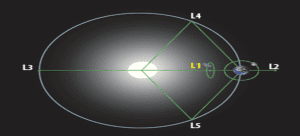THE CONTEXT: On January 6, 2024, a line of commands transmitted by scientists and engineers of the ISRO which initiated onboarding operation of Aditya-L1 spacecraft that guided it into orbit around an imaginary point in space. Thus, Aditya-L1 reached its destination, around the L1 Lagrange point, from where it will have an unrestricted view of the sun for its expected lifetime of five years.
ABOUT ADITYA-L1:
- Aditya-L1 is an observatory-class solar mission that will study the sun with seven instruments:
- VELC, a coronagraph to study the uppermost layer of the sun’s atmosphere
- SUIT, an ultraviolet imaging telescope
- SoLEXS and HEL1OS, to study solar flares and coronal mass ejections
- ASPEX and PAPA, to study the solar wind and plasma
- A set of digital magnetometers to measure properties of the magnetic field around the spacecraft.
- ISRO picked the L1 Lagrange point 1.5 million km from the earth in the earth-sun direction and one of five Lagrange points in the earth-sun system. It is because the gravitational influences of the two bodies interact such that a smaller body here will not experience a net tug towards either. So, Aditya-L1 can stay at L1 while expending little fuel.
- Aditya-L1 supplements India’s history of observing the sun dating back to the Kodaikanal Solar Observatory, which commenced operations in 1901 by lofting it into space.
- There arises issue of public perception on this mission. Many continue to expect the Indian spacecraft to capture hi-resolution photographs of the cosmos without much capacity and instrument. For example, while Aditya-L1 and AstroSat are big strides from India’s point of view, they pale in comparison to the imaging abilities of the James Webb Space Telescope, which is operated by three space agencies.

OBJECTIVES OF THE MISSION:
- Solar Observation:Aditya-L1 is designed to observe the Sun and its dynamics closely. It will provide valuable data on various aspects of the Sun, including its surface, corona, and the solar wind.
- Understanding the Solar Corona: One of the key mysteries it aims to address is the high temperature of the solar corona, which is much hotter than the Sun’s surface. Scientists want to better understand the reasons behind this temperature disparity.
- Space Weather Monitoring: Aditya-L1 serves as a space weather station. It monitors and collects data on space weather conditions near the Earth. This information is crucial for understanding how solar variability impacts the Earth’s climate and space weather, which can affect communication systems, power grids, and satellite operations.
- Studying Solar Activity:The mission aims to monitor solar activity, such as sunspots and solar flares which can have a significant impact on space weather and Earth’s climate.
- Space Weather Prediction: By constantly monitoring space weather parameters and collecting data, Aditya-L1 contributes to improving space weather prediction models. This is important for protecting satellites and infrastructure in space.
THE WAY FORWARD
- Collaboration: ISRO needs to expand its own and its collaborating institute’s public outreach efforts. It can be done by hosting open days focused on specific missions and commissioning science communication on new results at regular intervals.
- Including Public interest: ISRO should consider including components on missions that feed public interest. All these efforts will require funds, and ISRO should consider getting the funds from the government and private sector.
- Improving Satellite Operations: There is a need to improve satellite operations to allow for better spacecraft design and operation.
- Enhancing Research: Exploring the Sun’s complex behaviour, including its magnetic fields and plasma dynamics contributes to advances in fundamental physics and astrophysics. Insights gained from studying this experiment can enhance our research to understand the various solar processes.
THE CONCLUSION:
Aditya-L1 is an Indian space mission focused on solar observation, studying the Sun’s corona, monitoring space weather, and providing critical data for understanding the Sun’s influence on Earth’s climate and space environment. It aims to unravel the mysteries of the Sun while helping to predict and mitigate the impacts of space weather events on Earth and in space.
UPSC PREVIOUS YEAR QUESTIONS
Q. What is India’s plan to have its own space station and how will it benefit our space programme? (2019)
Q. Discuss India’s achievements in the field of Space Science and Technology. How the application of this technology has helped India in its socio-economic development? (2016)
MAINS PRACTICE QUESTION
Q. Discuss the objectives of Aditya L1 mission. How the success of this mission can help India to become a major global space power? Explain.
Spread the Word


Related posts
RE-IMAGINING INDIA’S ELECTORAL ROLL MANAGEMENT AFTER THE BIHAR SIR EPISODE
CONVERTING A DEMOGRAPHIC DIVIDEND INTO SUSTAINABLE SOCIO-ECONOMIC EQUITY
RE-ENGINEERING GLOBAL CLIMATE GOVERNANCE: FROM CONSENSUS GRIDLOCK TO CREDIBLE ACTION